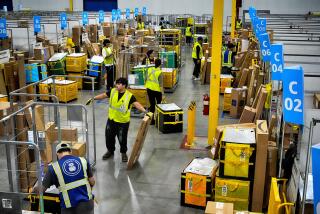THE ECONOMY : Output Rises as Labor Costs Stall
The indicators: The Labor Department reported revised figures on productivity and labor costs in the third quarter.
* What they did: Non-farm productivity--output per number of hours worked--rose at a seasonally adjusted annual rate of 2.9%, higher than the 2.7% initially reported. Productivity rebounded from a 2.1% decline in the second quarter. The decline in the April-June period was the first since a 2% decrease during the first quarter of 1993 and the steepest since a 3.7% plunge in the first quarter of 1989. The report also showed that unit labor costs, which represent about two-thirds of the cost of a product, were unchanged, the best showing since a 2.4% decline in the last quarter of 1993. A modest 0.1% increase was initially reported.
* What it means: Some economists say increasing productivity reflects the benefits of corporate restructuring and re-engineering, as well as a response to competitive pressures. Stable labor costs at this stage of the business cycle are also seen as good news and may have been held in check because workers fear losing jobs if they demand higher wages or more costly benefits, say economists.
* Highlights: Unit labor costs were held down despite an inflation-adjusted 3% increase in hourly compensation, compared to 0.7% in the second quarter and a rise of 6.1% in the first. Total business productivity, including farming, was up 3.5%, compared to a 2% drop in the second quarter. Manufacturing output--nearly 20% of U.S. business sector employment--rose 3.6% in the third quarter after increases of 5.6% in the second quarter and 6.4% in the first.
Productivity
Non-farm business productivity, percent change from previous quarter at annual rate, seasonally adjusted:
Third quarter 1994: Revised 2.9%
Source: U.S. Department of Labor
More to Read
Inside the business of entertainment
The Wide Shot brings you news, analysis and insights on everything from streaming wars to production — and what it all means for the future.
You may occasionally receive promotional content from the Los Angeles Times.










